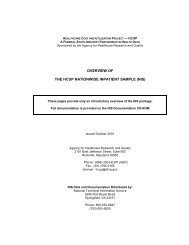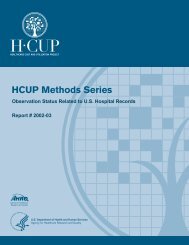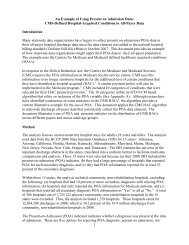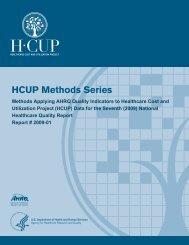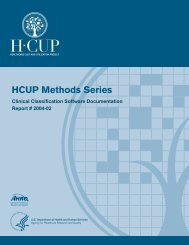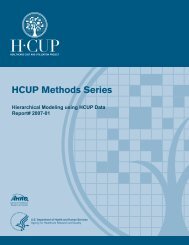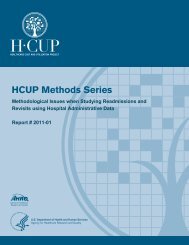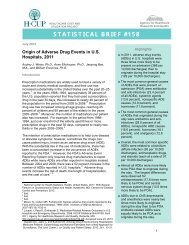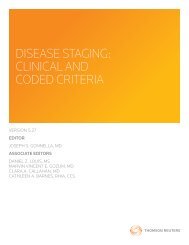Methods Applying AHRQ Quality Indicators to Healthcare ... - HCUP
Methods Applying AHRQ Quality Indicators to Healthcare ... - HCUP
Methods Applying AHRQ Quality Indicators to Healthcare ... - HCUP
You also want an ePaper? Increase the reach of your titles
YUMPU automatically turns print PDFs into web optimized ePapers that Google loves.
APPENDIX E:COMPARISON OF INPATIENT AND EMERGENCY DEPARTMENT USEFOR SELECTED PQIs AND PDIsFor the 2011 NHQR, <strong>HCUP</strong> data were used <strong>to</strong> examine national and regional differences ininpatient and emergency department (ED) use for selected <strong>AHRQ</strong> Prevention <strong>Quality</strong> <strong>Indica<strong>to</strong>rs</strong>(PQIs) and related Pediatric <strong>Quality</strong> <strong>Indica<strong>to</strong>rs</strong> (PDIs). Table E-1 in this appendix contains a lis<strong>to</strong>f PQIs and PDIs examined.The PQIs are measures of quality associated with processes and outcomes of care tha<strong>to</strong>ccurred in an outpatient or an inpatient setting. The PQIs rely solely on hospital administrativedata and, for this reason, are screens for examining quality that may indicate the need for morein-depth studies. Experts have suggested that using both inpatient and emergency room datamay give a more accurate picture of avoidable visits/admissions for some ambula<strong>to</strong>ry caresensitive conditions which can be identified by certain PQIs and PDIs.Two <strong>HCUP</strong> databases were used for the analysis:The <strong>HCUP</strong> Nationwide Emergency Department Sample (NEDS), a nationally stratifiedsample of hospital-based EDs from <strong>HCUP</strong> States that contribute ED data (28 States inthe 2008 NEDS).The <strong>HCUP</strong> Nationwide Inpatient Sample (NIS), a nationally stratified sample of hospitalsfrom <strong>HCUP</strong> States that contribute inpatient data (42 States in the 2008 NIS).The 2008 NEDS contains approximately 28.5 million ED events from 980 hospital-based EDs.The NEDS includes information on ED visits that do not result in an admission (i.e., treat-andreleasevisits and transfers <strong>to</strong> another hospital) as well as discharge information on patientsinitially seen in the ED and then admitted <strong>to</strong> the same hospital. For 2008, the NIS containsroughly 8.2 million inpatient discharges from more than 1,000 hospitals. Discharge-levelweights included with the NEDS and NIS are used <strong>to</strong> produce national estimates.Several steps were taken <strong>to</strong> prepare the <strong>HCUP</strong> databases: (1) QI software review andmodification, (2) acquisition of population-based data, (3) general preparation of <strong>HCUP</strong> data,and (4) identification of statistical methods.1. QI Software Review and Modification. A modification of PQI Version 4.1 was used.The PQIs were developed for use with hospital inpatient discharge data. No guidelinesfor applying the <strong>AHRQ</strong> QIs <strong>to</strong> emergency department data were available when thisanalysis began. Some of the events in the NEDS are visits for patients initially seen inthe emergency room and then admitted <strong>to</strong> the same hospital (an “ED admission”), andsome NEDS events are ED visits that do not result in an inpatient admission (e.g., treatand-releasevisits and transfers <strong>to</strong> another hospital). About 16 percent of records in the2008 NEDS represent an ED admission. The PQIs rely on the first-listed diagnosis code(DX1) <strong>to</strong> identify cases with the outcome of interest. For ED admissions, DX1 is theprincipal diagnosis code and reflects the condition established <strong>to</strong> be chiefly responsiblefor a patients’ admission <strong>to</strong> the hospital. Unfortunately, principal diagnosis is not clearlydiscernible for ED visits that do not result in admission. Coding instructions for outpatientdata specify that the first-listed diagnosis is supposed <strong>to</strong> be the "reason for visit," whichis different than the principal diagnosis. Even though DX1 in ED data is not necessarilythe principal diagnosis, using DX1 preserves the concept from the PQI algorithm that the<strong>Methods</strong> for <strong>HCUP</strong> Data in 2011 NHQR and NHDR E-1December 9, 2011



